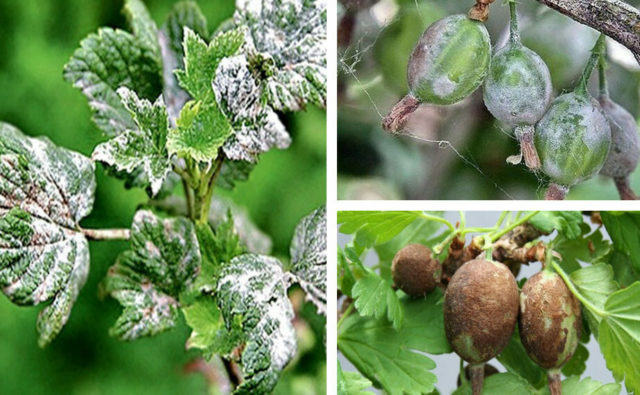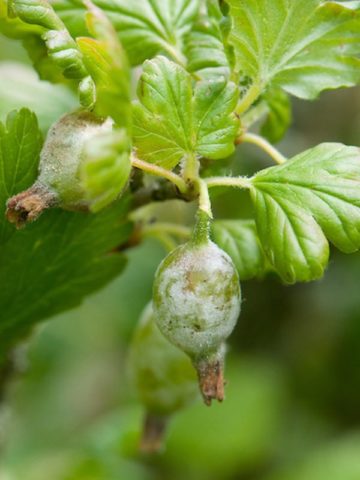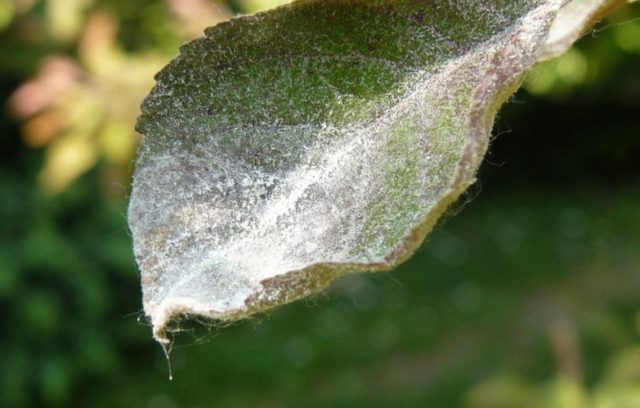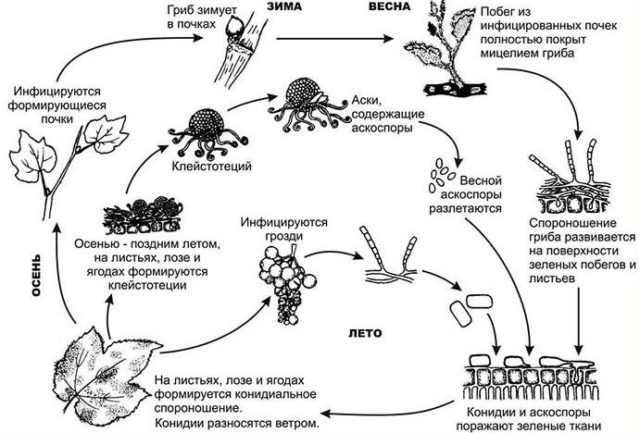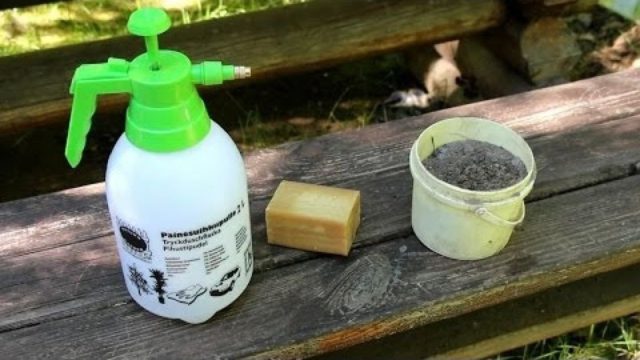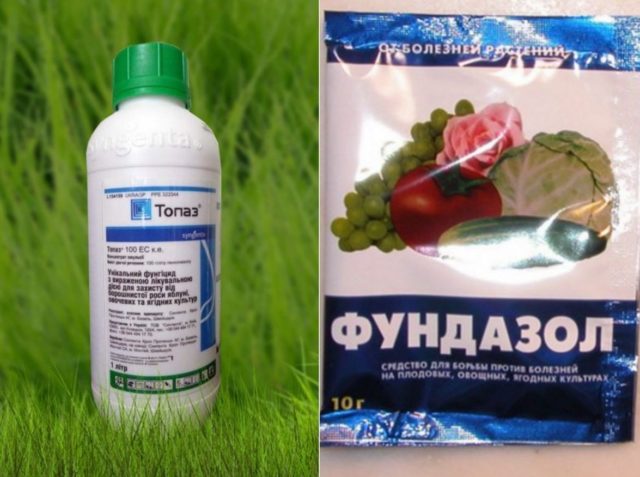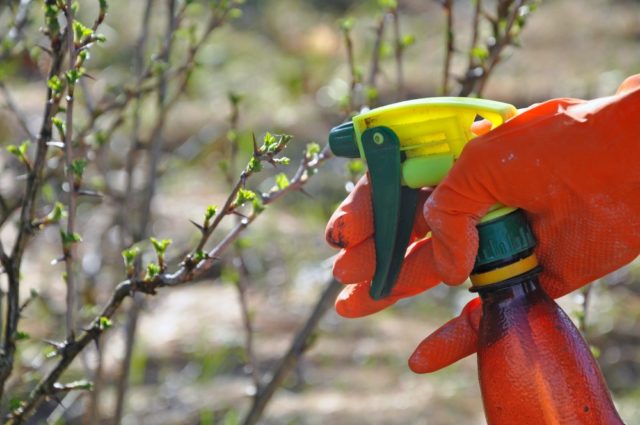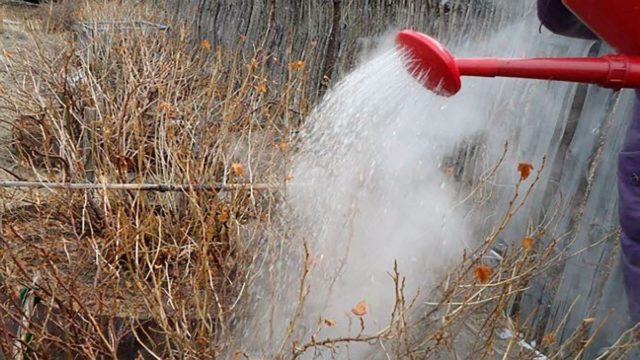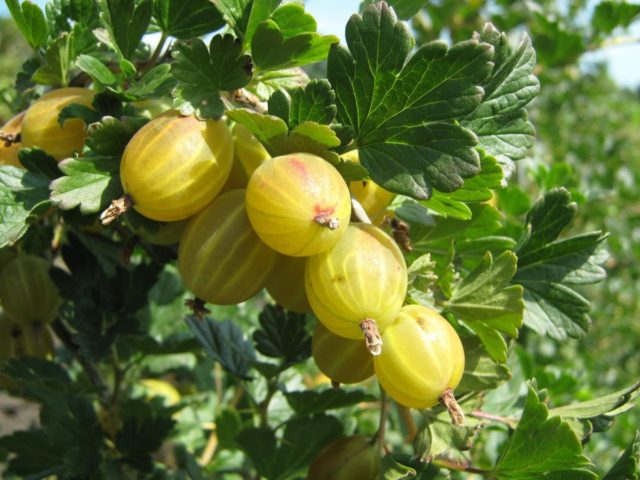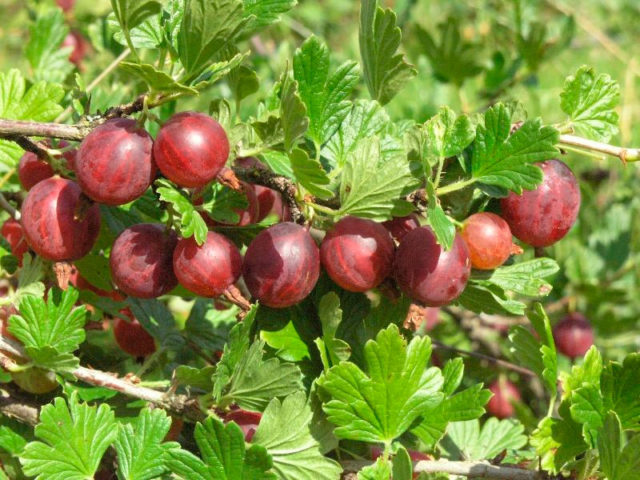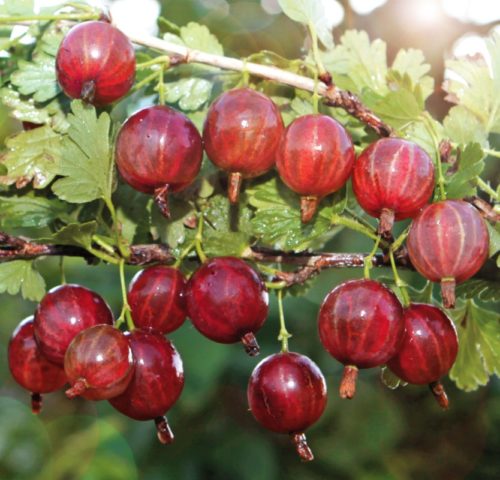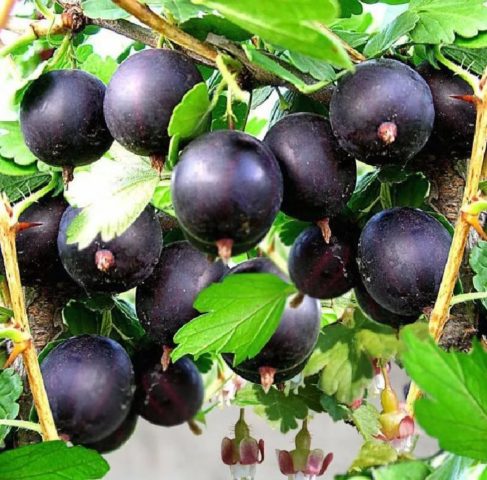Content
Powdery mildew is a common disease affecting many horticultural crops. These include berry bushes, which include gooseberries. Next, it will be discussed when it is better to treat gooseberries from powdery mildew in the spring, which preparations are best for this and what results it can bring.
Signs of powdery mildew on gooseberries
The causative agent of powdery mildew is a fungus that infects all aerial parts of the plant: shoots, berries, leaves. It usually appears at the beginning of summer, the gooseberry is covered with a white bloom, the affected areas look as if they were sprinkled with flour or light ash. Because of this, the disease is often referred to as linen or ash. Over time, the plaque darkens, turns brown and takes on a dense structure. The affected shoots stop growth, deform and dry out, the leaves turn brown, curl and dry completely, the gooseberry berries crumble before they mature, crack or become covered with a white bloom, and then a dense brown crust.
The photo below shows a white bloom of powdery mildew on gooseberry leaves and affected berries.
Over time, the disease progresses, the spores of the fungus are carried by wind and water to other parts of the bushes and neighboring plantings. If you do not take measures for treatment, the bush will completely die within 2-3 years.
There are 2 types of powdery mildew:
- American (sforoteka). Forms a mealy bloom on young leaves and shoots, which eventually acquires a felt structure and brown color.
- European. It manifests itself in the form of a thin web-like plaque on the leaves. The fruit bodies of the fungus are small, black. Nowadays, it is very rare, since at the beginning of the last century it was almost everywhere replaced by American gooseberry powdery mildew.
Signs of a gooseberry lesion with this fungal disease can be seen by the characteristic white bloom, which is easily erased.
Causes of infection and distribution features
Most often, the causes of powdery mildew damage are unfavorable weather conditions, coupled with improper care of shrubs or with a complete lack thereof. Excessive moisture and thickening of the plantings, the presence of fallen leaves and debris in the root zone contribute to the development of the disease. Under conditions of difficult air exchange, the fungus develops intensively, gradually spreading throughout the entire aerial part of the plant.
Another factor that increases the risk of gooseberry powdery mildew disease is an excess of nitrogen fertilizers or fresh organic matter, manure or chicken droppings, which are fed to berry bushes. The opposite situation is no less dangerous. If the gooseberry bush grows on poor, unfertilized soil, then the risk of fungal growth increases.Often the disease is the result of improper pruning of the bush. If you do it too much, the gooseberry weakens and can get sick.
The figure clearly shows 2 stages of development of the fungus: conidial and marsupial. Conidial sporulation, or mycelium, is the same white powdery bloom on the shoots and leaves of gooseberries. After infection of leaves and young shoots, the fungus enters the second phase - marsupial. Brown bloom on various parts of the plant is nothing more than a mycelium with the fruiting bodies of the fungus. In this form, the fungus hibernates. In the spring, ascospores ripen, which open in spring along with the blooming of the leaves. Discarded ascospores infect only young leaves and shoots, berry ovaries, again forming the same white bloom.
How to deal with gooseberry powdery mildew
The best way to fight disease is through prevention. If powdery mildew does appear on the gooseberry berries, then measures must be taken immediately.
Agrotechnical measures to combat powdery mildew on gooseberries
Proper farming practices can prevent powdery mildew disease in gooseberries or stop the disease at an early stage. First of all, this concerns the choice of varieties at the planting stage. Among those resistant to powdery mildew, the following varieties of gooseberries can be distinguished:
- Harlequin.
- Gingerbread man.
- Finnish.
- Houghton.
Every spring and autumn, it is necessary to inspect and sanitize the bushes, removing thickening, broken and dry branches, as well as shoots with signs of infection. Fallen foliage in spring and autumn should be completely removed from the root zone and burned or taken out and buried outside the border of the site.
How to save gooseberries from powdery mildew with folk remedies
Among the ways to combat this fungal disease, there are many folk, proven by many generations of gardeners. For treatment, you can use the following formulations.
- Infusion of wood ash. 1 kg of ash is soaked in 10 liters of heated water, stir well and let it brew for several days. The resulting ash infusion is filtered, and then the gooseberry bushes, on which there is a white bloom, are treated with them three times, making the intervals between applications for 2 days.
- Iodine tincture and milk whey. To prepare a composition for treating gooseberries in 1 liter of serum, you need to add 1-2 drops of an ordinary medical solution of iodine.
- Soapy solution with soda. For 10 liters of water, 50 g of laundry soap and 2 tbsp. l. baking soda. It is better to grate the soap before mixing, this will accelerate its dissolution.
- Zelenka (alcohol solution of brilliant green). Add 1-2 drops of brilliant green to 10 liters of water.
- Aspirin. 2 tablets of acetylsalicylic acid must be diluted in 3 glasses of water.
- Garlic arrows. To prepare the infusion for spraying, pour water into ½ bucket of fresh garlic arrows. Insist for at least a day before use.
- Mustard. 2 tbsp. l. mustard powder is poured with a bucket of boiling water. After mixing and cooling, the composition can be used to spray gooseberries.
Usually gooseberries are processed in the evening, in dry, cool weather. When spraying, it is very important that the composition also falls on the back of the leaves. It is advisable to process the root zone together with the shrub.
How to deal with white bloom on gooseberries with chemicals
Treating gooseberries with chemicals is often the only possible way to save the shrub, especially in advanced cases. Traditionally, gardeners have used fungicides to combat fungal diseases - chemical compounds with a pronounced antifungal effect. Such substances include, for example, copper compounds.
Here are some remedies for gooseberry powdery mildew.
- Copper sulfate. A widespread remedy for gooseberry powdery mildew, which has long been successfully used by many gardeners to combat many fungal diseases. It is a bright blue powder. It dissolves well in water. To prepare a solution for processing gooseberries for 10 liters of water, you need to take 40 g of copper sulfate. To increase the stability of the solution and its wetting ability, 100 g of shavings of laundry soap are introduced into it.
- Topaz. An effective fungicide based on penconazole. The mechanism of action of this drug is to suppress the spores of the fungus, under the influence of penconazole, they completely stop growing. The drug penetrates perfectly into plant tissues, its effectiveness does not depend on air temperature and humidity.
- Hom. This is nothing more than an abbreviation for the words "copper oxychloride". An effective fungicide, almost a complete analogue of the famous Bordeaux liquid - a solution of copper sulfate in lime milk. Sold dry. Before use, the mixture is diluted in water in the correct proportion. It is easily washed off with water, therefore, processing is not performed in cloudy weather.
- Fundazol. Benomyl-based fungicide that inhibits not only fungi, but also some insect pests, such as spider mites. The drug is non-toxic, well absorbed by all parts of the plant. Can be used to process gooseberries at various temperatures.
- Vectra. The basis of the drug is a mixture of dichlorophenyl and triazole. Effective against many fungal diseases, stops the growth of pathogens. Non-toxic, does not have a negative effect on plants and animals. It is quickly absorbed by any tissue and spreads to all parts of the shrub
Often, gardeners use a solution of colloidal sulfur against powdery mildew. For 10 liters of water, 70-80 g of sulfur are needed. It is necessary to use a solution for processing gooseberries only in a freshly prepared form, it is not stored for a long time. And also you can not use it in conjunction with other drugs.
How to cure gooseberries from powdery mildew with biological products
The action of biological products against powdery mildew is based on microorganisms that, either themselves or in the process of their vital activity, inhibit pathogenic fungi, suppress their growth, and prevent reproduction. Unlike chemicals, they are absolutely harmless to plants and animals, they can be used even during the ripening of berries. The disadvantage of biological products is a rather short-term effect, after about 2 weeks, their activity decreases sharply. Therefore, it is recommended to repeat the treatment monthly. Biologics include:
- Gaupsin.
- Trichodermin.
- Fitosporin.
Rules for dealing with powdery mildew on gooseberries
Before starting the treatment of gooseberries, the bushes must be cleaned of diseased and dried shoots, cut off rotten berries, remove fallen leaves, debris and weeds from the root zone. All drugs must be diluted strictly according to the instructions, exactly following the prescribed dosages. With early detection of signs of the disease, it is necessary to use the most gentle, folk methods. After that, it is imperative to evaluate the effectiveness of the use of a particular drug. If the disease continues to progress, it is necessary to switch to more radical methods based on the use of biological products or fungicides.
It is better to start processing gooseberries from powdery mildew in early spring.At this stage, until the buds bloom, it is necessary to spray the bushes with a solution of copper sulfate. It is necessary to process not only shoots, but also the soil in the root zone. Re-processing is carried out after flowering. The third time the gooseberry bushes are sprayed after harvest, without waiting for the leaves to fly around. Such treatments are preventive. If spraying is carried out for medicinal purposes, then drugs are used that are most suitable for the degree of damage and the period of vegetative development of the gooseberry.
Informative video about how to treat gooseberry powdery mildew:
Prevention measures
Preventive measures can significantly reduce the likelihood of powdery mildew on gooseberry bushes. These measures include the following:
- Avoiding thickening of the landings. Be sure to observe the intervals between adjacent bushes (at least 1.5 m), remove thickening shoots.
- Spring treatment of gooseberries from powdery mildew with boiling water. In early spring, before the start of the growing season, the bushes need to be scalded with very hot water, in which a small amount of potassium permanganate or a few tablespoons of soda is diluted. The measure is effective both against pathogens of fungal diseases and against pests, the larvae of which overwinter in the folds and cracks of the bark.
- Sanitary reading. Every year, in early spring and autumn, it is necessary to remove dry, broken and damaged branches, as well as remove fallen leaves from the root zone.
- Installation of bushes fencing. The bushes should not be allowed to "fall apart" and touch the ground with their shoots.
- Spraying. Preventive treatment can be carried out not only with a solution of copper sulfate. You can use an infusion of mullein, ash, or soda ash.
- Refusal to use fresh organic fertilizers. Manure and chicken droppings contain a large amount of nitrogen, which provokes the development of powdery mildew on gooseberries.
The more thoroughly preventive measures are taken, the less likely powdery mildew will appear on gooseberry bushes. And even if powdery mildew did appear on the gooseberry, it is much easier to cure well-groomed bushes and you do not have to use serious pesticides for this.
Powdery Mildew Resistant Gooseberry Varieties
When choosing a gooseberry variety, you should pay attention to varieties that are resistant to powdery mildew. Although there is no complete immunity from this disease, some representatives of these berry bushes are affected by the disease much less often. These include the following gooseberry varieties:
- Ural grapes.
- Beryl.
- Salute.
- Ural emerald.
- Gingerbread man.
- Commander.
Conclusion
Treating gooseberries from powdery mildew in the spring means protecting your future harvest. Even if in the past season the appearance of the disease was not registered, this procedure should not be neglected. This can significantly reduce the likelihood of the appearance of the disease, and if the entire complex of preventive measures is carried out on time, then it can be completely excluded.
